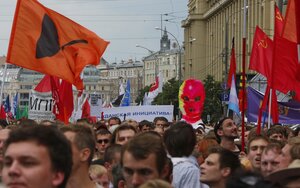Russia protests keep democracy dream alive
The Russia protests on Tuesday tell Putin that the popular hopes for democracy are alive and kicking. His subtle suppression of dissent only hurts Russia's opportunity to modernize its economy.

Opposition supporters march during a massive rally in Moscow on Tuesday, the first massive rally against President Vladimir Putin's rule since his inauguration.
Alexander Zemlianichenko/AP Photo
Twenty-one years ago on June 12, a dream of democracy was born for Russia. That’s when Boris Yeltsin was elected president, declaring independence from a soon-to-fall Soviet Union. Yet on this 21st anniversary, tens of thousands of Russians took to the streets, hoping to recapture that lost dream.
Tuesday’s protests were the first against Vladimir Putin since he took back the presidency May 7. He had hoped his victory in an unfair election might end a string of pro-freedom rallies. Instead, he’s being forced to suppress a growing challenge to his rule – and to do so without scaring off the foreign investors he needs to revive an economy in decay.
The protesters and Mr. Putin represent two very different models for Russia. His approach is like China’s: Use strong state power to quell dissent while modernizing the economy. Many Russians go along with that. In fact, one poll finds most of them say they have no say over Russia’s future.
But the urban middle class sees too much corruption and a loss of freedom in Putin’s model. Individual rights are ignored and minorities suppressed. They look to the West, not China, for inspiration.
This conflict in Russia’s soul helps explain why Putin can’t merely shoot the protesters as his ally in Syria, Bashar al-Assad, does. Instead, his tactics are more subtle, reflecting his days as a Soviet spy.
Just before the protests began on Tuesday, the websites of protest groups were shut down. On Monday, the homes of seven protest leaders were searched. They were also ordered to report to police as the protest began.
And a few days before, the Putin-controlled parliament rushed through a law that sets a $9,000 fine for anyone who participates in rallies that cause harm to people or property. The Duma also broadened the definition of protests.
This clampdown on the freedom of speech and assembly was even opposed by the political parties that are allied with the dominant, pro-Putin party, United Russia. And the Obama administration, which is focused mainly in winning Russia’s help on foreign issues, was forced to express “deep” concern over the crackdown.
The protesters have no single leader – on purpose. This prevents Putin from simply jailing the main organizers. It also reinforces the fact that the protests represent popular feeling.
The impression of widespread unrest could hinder Putin’s plans to create 25 million new high-tech jobs by 2020. Western investors are already wary of Russia’s rampant corruption and demographic decline. Many wealthy Russians have fled abroad.
Like the Arab Spring, pro-freedom protests in Russia serve as a mirror on the self-preservation tactics of a corrupt regime. Eventually the protesters may need to better organize in hopes of winning local elections later this year that may be less rigged than the recent national ones. Then Russians in rural areas can add their dissent and, like Rip Van Winkle, wake up after a 20-year slumber to dream again.

